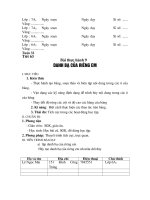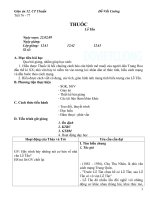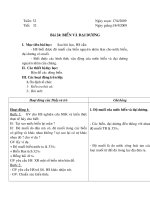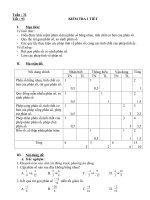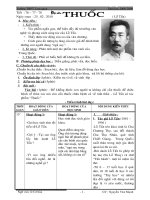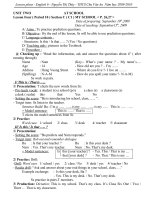iếng Anh 6 Tuần 32 Tiết 76 77 78
Bạn đang xem bản rút gọn của tài liệu. Xem và tải ngay bản đầy đủ của tài liệu tại đây (208.08 KB, 12 trang )
<span class='text_page_counter'>(1)</span><div class='page_container' data-page=1>
<b>Date of preparing: 27/3/2019 </b>
<b>Period 86</b>
<b>Unit 14: MAKING PLANS</b>
<b> Lesson 4: B5 - 6 (P.142)</b>
<b>A. Aims</b>
- By the end of the lesson, Ss will be able to use "future simple tense" to express
future plans.
<b>1. Knowledge:</b>
- Know how to use “going to”.
+ Further listening and reading practice with “going to”.
+ SS should be taught how to talk about free time plans and about plans.
- Grammar: What are you going to do tomorrow?
I’m going to do my homework.
<b>2. Skills:</b>
- Practice 4 skills: Listening, speaking, reading and writing.
<b>3. Attitude: </b>
<b>- Educate Ss to have good consciousness in order to study in class and know how</b>
to future simple tense" to express future plans; know how to use “going to”.
<b>B. Teaching aids.</b>
- Teacher: Teacher’s book, Students’ books, workbook, lesson plan, picture, tape,
speaker, computer.
- Students: Textbook, Students’book, workbook, revise old lesson.
<b>C. Methods.</b>
- Some techniques can be used: Chatting, Rub out and remember, Brainstorm,
Prediction, Lucky numbers.
- Pair work, work individually
<b>D. Procedure</b>
<b>I. Organization (1’) </b>
- Greetings: Good morning everybody
- Who’s absent today ?
<b>Class</b> <b>Date of teaching</b> <b>Absent students</b>
6A 02/4/2019
6B 02/4/2019
6C 02/4/2019
<b>Teacher’s activities</b> <b>Students’ activities</b>
<b>II. Warm up: (5’)</b>
<b>* Chatting:</b>
- T uses a computer and run
throught it.
- T asks Ss question about the
beautiful places to elicit the new
lesson.
- Ss listen and answer.
<b>* Questions:</b>
</div>
<span class='text_page_counter'>(2)</span><div class='page_container' data-page=2>
<b>III. New lesson.</b>
<b>1. Pre-teach (4’)</b>
<b>* Vocabulary </b>
- Ask to listen one time
- Ss: Listen
- T explains some new words and
using mime, picture, translation to
present them.
-Ss: listen, copy down and repeat.
<b>* T checks Vocabulary: Rub out</b>
and remember.
- Guide ss to read the word and rub
out one by one.
- Ss: read and remember the words
- Ask ss to go to the board and
rewrite the words again.
- ss: write individually one by one.
- T corrects with whole class then ss
copy down the new words.
<b>* Pre-questions. (6’)</b>
<i>- Set the scene: Minh and his</i>
<i>friends are going to have a picnic.</i>
<i>You guess what they are going to do</i>
<i>by answering some questions.</i>
<i>- T uses a computer and run through</i>
it on the board.
- Give feedback
<b>2. While-teach (5’)</b>
- T reads the text.
- Ss: Listen and repeat then Ss read
individually -> check their
prediction
- Checking prediction
- T gives answer key.
<i><b>* Brainstorm (7’)</b></i>
- Have Ss list the things which they
often bring for a camping vacation.
- Ss: free talk.
- Stick the poster on the board
<b>I. Vocabulary</b>
- (to) bring: mang (theo)
- a camera: máy ảnh
- (to) take a photo: chụp hình
<b>* Questions: B5</b>
a. Where are they going to do?
b. What three things are they going to
bring?
c. What are they going to do there?
<b>* Answer keys</b>
a. Near a lake
b. A camera, food and drink
c. Take photos
<b>II. Listen: B6</b>
<b>1. List the things which they often</b>
<b>bring for a camping vacation.</b>
food a kite
</div>
<span class='text_page_counter'>(3)</span><div class='page_container' data-page=3>
- Have Ss guess and match the
names with the right pictures.
- Ss guess individually -> compare
with their partner.
- T writes the predictions on the
board.
- Ask Ss to listen twice.
- Give feedback.
<b>* Tape transcript.</b>
<i>Vui and her friends are going to</i>
<i>camp for 3 days in Sapa. Vui is</i>
<i>going to bring a tent and some food.</i>
<i>Lan is going to bring a ball. Ly is</i>
<i>going to bring her camera to take</i>
<i>some photos. Nga and Mai are</i>
<i>going to bring some drinks</i>
<i><b>* Prediction (9’)</b></i>
- Have Ss listen and check their
prediction.
- Give answer key.
<i><b>* Writing.</b></i>
- Ask Ss to write about five girls.
- Ss write individually -> compare
with their partner.
- 2 Ss to write on the board.
- T corrects with whole class.
<b>3. Production (6’)</b>
<i><b>* Lucky numbers.</b></i>
- Guide Ss to play the game.
- T divides Ss into 2 teams: Team
A-B.
a tent
warm clothes
<b>2. Guess and match the names with the</b>
<b>right pictures: B6</b>
<b>Guessing</b> <b>Listening Correction</b>
Vui : d
Ly : a
Lan : e
Mai : c
Nga : b
<b>* Listen and check their prediction. </b>
<i><b>Answer key.</b></i>
Vui : c,e
Ly : b
Lan : a
Mai : d
Nga : d
<b>3. Write about five girls: Vui, Ly, Lan,</b>
<b>Mai and Nga.</b>
<i><b> Ex: - Vui is going to bring some food</b></i>
<i> - Ly is going to bring her camera</i>
- Lan is going to bring a ball
- Nga and Mai are going to bring some
drinks.
</div>
<span class='text_page_counter'>(4)</span><div class='page_container' data-page=4>
cameras?
<i> - Nam and Ly </i>
2. Name 2 people, who are going to bring
food?
<i>- Tuan and Vui</i>
3. Where is the boys’picnic goingto be?
<i>- Near a lake</i>
5. Where are the girls going to go
camping?
<i>- Sapa</i>
8. Name 3 people, who are going to bring
drink?
<i>- M inh, Nga and Mai</i>
9. What’s Lan going to bring?
<i>- A ball</i>
10. Who’s going to bring a tent?
<i>- Vui</i>
11. How many days are the girls going to
camp for?
<i>- three days</i>
<b>4. Summary (1’)</b>
- T asks - Ss answer:
- What are you going to do this summer vacation?
I’m going to …….
- Where are you going to go camping?
I’m going to camp in…….
<b>5. Homework: (1’)</b>
- Learn vocabulary by heart and practice reading dialogue.
- Prepare next part C.
- Do exercises in workbook.
<b>* Evaluation:</b>
………
………
………
………
<b>Date of preparing: 27/3/2019 </b>
<b>Period 87</b>
<b>Unit 14: MAKING PLANS</b>
<b> Lesson 5: C1 - 3 (P.147)</b>
</div>
<span class='text_page_counter'>(5)</span><div class='page_container' data-page=5>
- By the end of the lesson, students will be able to make suggestion and
responding
and do futher practice in “want to do”.
<b>1. Knowledge:</b>
<b>-</b>
Grammar: + Let’s. . . ; What about . . . ; Why don’t we . . .+ To want to do sth
<b>2. Skills:</b>
- Practice 4 skills: Listening, speaking, reading and writing.
<b>3. Attitude: </b>
<b>- Educate Ss to have good consciousness in order to study in class and know how</b>
to make suggestion and responding and do futher practice in “want to do”,
Words cues drill.
<b>B. Teaching aids.</b>
- Teacher: Teacher’s book, Students’ books, workbook, lesson plan, picture, tape,
speaker, computer.
- Students: Textbook, Students’book, workbook, revise old lesson.
<b>C. Methods.</b>
- Some techniques can be used: pair work, chatting, Guessing, mapped dialogue,
What and Where.
- Pair work , work individually , groupwork.
<b>D. Procedure</b>
<b>I. Organization (1’) </b>
- Greetings: Good morning everybody
- Who’s absent today ?
<b>Class</b> <b>Date of teaching</b> <b>Absent students</b>
6A
6B
6C
<b>Teacher’s activities</b> <b>Students’ activities</b>
<b>II. Warm up: (3’)</b>
<b>* Chatting </b>
- T uses a computer and run
throught it.
- Ask Ss some questions
- Ss: Answer (Whole class)
<b>III. New lesson.</b>
<b>1. Pre-reading</b>
<b>* Vocablary: (6’)</b>
-T uses pictures, translation to
present some new words
- T reads model ( twice )
<b>* Questions:</b>
1. Where do you often go on vacation?
2. How do you often go on vacation?
<b>I. Vocablary:</b>
- a pagoda: chùa
</div>
<span class='text_page_counter'>(6)</span><div class='page_container' data-page=6>
- Ss repeat – individually
(2 - 3 Ss)
<b>* T checks vocabulary by What</b>
and Where.
- T writes and circles the words
on the board
- Ask Ss to read all words
- T rubs out all words
- Ss read the words again (in the
circles)
- One by one go to the board to
write the words
- T corrects mistakes
- Ss copy down the new words in
their notebooks .
<i><b>* Pre –questions (3’)</b></i>
- Ss: Listen the tape once.
- Play the tape again and get Ss to
repeat.
<b>* Presentation dialogue: (3’)</b>
<b>C2 P.147</b>
- Let Ss guess to answer the
questions.
- Ss work individualy -> compare
with their partners.
- Give feedback.
<b>2. While-reading (7’)</b>
- Ask Ss to listen and repeat the
text in C1.
- Ss: Read silently and check their
prediction.
- T gives answer key.
- far (adj): xa
too far: quá xa- pagoda: chùa
- Let’s = let us: chúng ta hãy ...
- What about going...?: sao không đi….?
- Why don’t we...?: tại sao bạn…?
<b>II. Listen and read. Then practice in</b>
<b>groups. C1</b>
<i><b>* Questions:</b></i>
<i><b>1- Where are they going to go?</b></i>
<i><b>2- How are they going to travel?</b></i>
<b>* Answer keys:</b>
1. go camping
2. minibus
<b>III. Answer. Then write the answer in</b>
<b>your exercise book: C2 P.147</b>
Ex: What does Lan want to do?
She wants to go camping.
<b>* Answer keys:</b>
a. He wants to go to Hue
b. She wants to go to Huong pagoda
c. She wants to go on foot.
d. Because it is too far
e. He wants to go by bike.
f. Because it’s too hot.
</div>
<span class='text_page_counter'>(7)</span><div class='page_container' data-page=7>
- Let Ss play the role to practice
the dialogue C1.
- Get Ss to answer the question in
pairs.
- Call some pairs to demonstrate
in front of the class.
- Give answer key
- Explain the structures.
<b>* Word cues drill: (12’)</b>
<b>C3 P.148</b>
- T uses a computer and run
throught it.
- Have Ss make suggestion about
them.
- T models the 1st <sub> cue.</sub>
- T - Ss;
- Ss - T;
- Ss: half - half; open pairs, closed
pairs.
<i><b>IV. Structures: Đề nghị ai cùng làm gì</b></i>
<i><b>với mình.</b></i>
<i><b>a. Let’s play soccer. </b></i>
<i><b>=> Let’s + V . . .(chúng ta hãy….)</b></i>
b. What about going fishing?
<b>=> What about + V-ing . . . ?</b>
c. Why don’t we see a movie?
<b>=> Why don’t we + V . . . ?</b>
<i><b>* Câu trả lời đề nghị:</b></i>
<b>(+): Yes, that’s a good idea.</b>
<b> Yes, let’s</b>
Yes, good idea.
<b>(- ): No, it’s not a good idea.</b>
No, I don’t want.
<b>V. Practice: Using the suggestions to talk</b>
<i><b>about the sentences: C3 P.148</b></i>
<b>Ex: S1: go to the beach.</b>
S2: Let’s go to the beach.
Why don’t we go to the beach?
What about going to the beach?
1. play volleyball.
- Let’s……….…..………
2. go to the zoo.
- Why don’t we………..
3. play badminton.
- What about……….……….…..…
4. Why don’t we go camping?
- Let’s………..………..…..
5. Let’s listen to music.
- What about………..………..…
6. What about walking to school?
- Why don’t we………..…………..
<b>* Answer key:</b>
1. Let’s play volleyball.
2. Why don’t we go to the zoo?
3. What about playing badminton?
4. Let’s go camping?
</div>
<span class='text_page_counter'>(8)</span><div class='page_container' data-page=8>
<b>3. Post-reading:</b>
<b>* Mapped dialogue. (8’)</b>
- T uses a computer and run
throught it.
- Have Ss look at the mapped
dialogue and build the dialogue,
base on the dialogue on page 147
- Call on some pairs to talk in
front of the class.
<b>* Build the dialogue, base on the</b>
<b>dialogue on page 147.</b>
You Your friend
……….see a movie.
No, ….too hot…go to
the museum.
No, go by minibus
-No,…go to the
beach
-Yes, ……walk
-Yes.
<b>* Answer keys:</b>
<b>You: Let’s see a movie.</b>
<b>Your friend: No, I don’t. What about</b>
going to the beach.
<b>You: No, I don’t want. It’s too hot.</b>
Why don’t go to the museum?
<b> Your friend: Yes, let’s. Let’s walk.</b>
<b>You: No, go by minibus</b>
<b>Your friend: Yes. good idea.</b>
<b>IV. Summary (1’)</b>
- Ask Ss to repeat the lesson today.
- Ss: The suggestions.
a. Let’s . . . = Let us + V . .
b. What about + V-ing . . . ?
c. Why don’t we + V . . . ?
<b>V. Homework: (1’)</b>
- Learn by heart the structures the suggestions.
- Write 3 sentences to make suggestion.
- Prepare next part Grammar practice.
- Do exercises in workbook.
<b>* Evaluation:</b>
………
………
………
………
<b>Date of preparing: 27/3/2019 </b>
<b>Period 88</b>
<b>GRAMMAR PRACTICE 1 - 3 (P.150)</b>
<b>A. Aims</b>
- By the end of the lesson, students will be able to further practice in present
simple, Adverbs of frequencey, present progressive.
<b>1. Knowledge:</b>
</div>
<span class='text_page_counter'>(9)</span><div class='page_container' data-page=9>
- Practice 4 skills: speaking, reading and writing.
<b>3. Attitude: </b>
<b>- Educate Ss to have good consciousness in order to study in class and know how</b>
to further practice in present simple, Adverbs of frequencey, present
progressive.
<b>B. Teaching aids.</b>
- Teacher: Teacher’s book, Students’ books, workbook, lesson plan, pictures,
computer.
- Students: Textbook, Students’book, workbook, revise old lesson.
<b>C. Methods.</b>
- Some techniques can be used: Slap the board, Noughts and Crosses, Word cue
drill.
- Pair work, work individually.
<b>D. Procedure</b>
<b>I. Organization (1’) </b>
- Greetings: Good morning everybody
- Who’s absent today ?
<b>Class</b> <b>Date of teaching</b> <b>Absent students</b>
6A
6B
6C
<b>II. Warm up: (15')</b>
<b>TEST 15’</b>
<b>ENGLISH WRITTEN TEST 15’ (N.4)</b>
<i><b>Name: ……….. Class: 6</b></i>
<b>I. Read the passage and fill True (T) or False (F): (4.0p)</b>
Nam is going on vacation this summer. First he is going to visit Hue for a week. He is
going to stay with his uncle and aunt. Then he is going to stay at a friend’s house in Nha
Trang Beach for three days. He is going to visit the beach and swim. Finally, he is going
to visit his grandparents in Ho Chi Minh City. He is going to stay with them for a week.
…… 1. Nam is going on vacation this summer.
…… 2. He is going to Nha Trang for a week.
…… 3. He is going to visit the beach and swim.
…… 4. First, he is going to visit his grandparents in Ho Chi Minh City.
<b>II. Reorder the words to make sentences. (6.0p)</b>
1. room/ What about/ my/ music/ listening/ in / to?
- ………….………..………
2. It /often/ is/ hot/ summer/ in/ the.
- ………..….………
3. Let’s/ go/ movies/ to/ the.
- ………..?
4. They/ sailing/ sometimes/ fall/ go/ in/ the.
- ……….……….………..
5. Why/ minibus/ don’t/ we/ by/ go?
</div>
<span class='text_page_counter'>(10)</span><div class='page_container' data-page=10>
- ……….………
<b>ANSWER KEYS</b>
<b>I. Read the passage and fill True (T) or False (F): (4.0p)</b>
1.T 2.F 3.T 4.T
<b>II. Reorder the words to make sentences. (6.0p)</b>
1. What about listening to music in my room?
2. It is often hot in the summer.
3. Let’s go to the movies.
4. They sometimes go sailing in the fall. (We)
5. Why don’t we go by minibus? (Let’s)
6. What are they doing?
<b>Teacher’s activities</b> <b>Students’ activities</b>
<b>III. New lesson.</b>
<b>1. Presention</b>
<b>* Present simple tense: 1 (P.150)</b>
<b>Examples: (3’)</b>
- T gives out the examples and
form.
- T uses a computer and run
throught it.
- Have Ss complete the dialogues
- Give feedback.
<b>* Adverbs of frequency: 2 (P.150)</b>
<b>Slap the board: (3’)</b>
- Read the words in English
-Ss: listen and slap the words on the
board.
- Ss : play in teams
-T : correct if necessary.
<b>* Examples: (3’)</b>
- T gives out the examples and
form.
<b>I. Present simple tense: 1 (P.150)</b>
<b>Ex: I play volleyball</b>
He walks to school
* Form:
S + V/ V(s/es)
<b>* Answer keys: </b>
a.do-like-do-play-do-don’t
doesn’t
c.Do-do-do-don’t
<b>II. Adverbs of Frequency: 2 (P.150)</b>
Luôn luôn không bao giờ
thỉnh thoảng
thường xuyên hai lần một năm
một lần một năm
<b>Ex: They sometimes walk to school in</b>
the mountains
The weather is often cold in the
winter
</div>
<span class='text_page_counter'>(11)</span><div class='page_container' data-page=11>
<b>* Noughts and Crosses: (3’)</b>
<b>2/p.150 </b>
- Ask Ss to play games.
- Give instructions.
- T devides Ss into 2 teams: A-B
- Find the winner.
<b>* Present progressive tense: </b>
<b> (3 P.151)</b>
<b>* Examples: (2’)</b>
- T gives out the examples and
form.
<b>2. Practice</b>
<b>* Word cue drill: (6’) </b>
- Have Ss recall the structure :
S + be + V-ing...
- Set the scene: Today Hung’s on
vacation.
- Ss: look at the charts and practice
1. Adv of fre.. + V/ V(s/es)
2. Be + Adv of fre..
1.TV 4.the movies 7.the store
2.swimming 5.your mom 8.fishing
3.tabletennis 6.camping 9.babminton
<b>Ex:</b>
<i><b>a. A: How often do you watch</b></i>
<i>television?</i>
<i> B: six times a week</i>
<b>* Answer keys:</b>
<b>b.A: How often do you go to the</b>
movies?
B: Twice a week
<i><b>c. A: How often do you help your mom?</b></i>
<i> B: seven times a week</i>
<i><b>d. A: How often do you go to the store?</b></i>
<i> B: once a week</i>
<i><b>e. A: How often do you play sports?</b></i>
<i> B: three times a week</i>
<i><b>f. A: How often do you go fishing?</b></i>
<i> B: once a month</i>
<i><b>g. A: How often do you go swimming?</b></i>
<i> B: once a week</i>
<b>III. Present progressive tense:</b>
<b> (3 P.151)</b>
<b>Ex: I am listening to radio now</b>
We are swimming in the river
At the moment.
<b>* Form:</b>
Be + V-ing
<b>* Answer keys:</b>
a. am watching
playing
is winning
b. is cooking
are not
is
</div>
<span class='text_page_counter'>(12)</span><div class='page_container' data-page=12>
asking and answering.
<b>3. Production (7’)</b>
- Ask ss to answer the questions.
- Ss answer the questions in groups
of 5.
<b>IV. Answer the questions:</b>
1. What do you do in your freetime?
2. What do you do after school?
3. How often do you help your mom?
<b>IV. Summary (1’)</b>
- Ask Ss to repeat the lesson today.
<b>V. Homework: (1’)</b>
- Review all the structures
- Prepare next part Grammar practice.
<b>* Evaluation:</b>
</div>
<!--links-->
